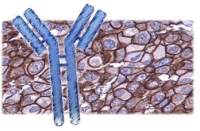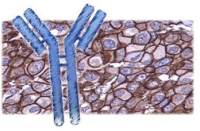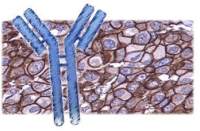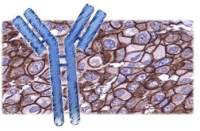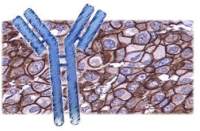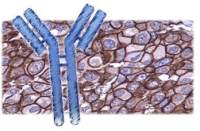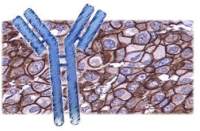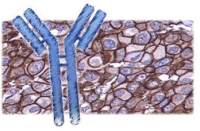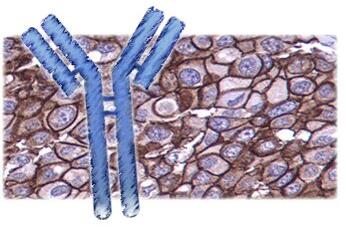
产品详情
文献和实验
相关推荐
供应商 :上海联迈生物工程有限公司
库存 :大量
靶点 :详见说明书
级别 :1
目录编号 :LM-11251R-FITC
克隆性 :多克隆
抗原来源 :Rabbit
保质期 :1年
抗体英文名 :Anti-EPS15/FITC
抗体名 :Anti-EPS15/FITC
标记物 :FITC标记
宿主 :Human, Mouse, Rat, Pig,
适应物种 :Human, Mouse, Rat, Pig,
免疫原 :详见说明书
亚型 :IGg
形态 :粉末、液体、冻干粉
应用范围 :ICC=1:50-200 IF=1:50-200
浓度 :1mg/ml
保存条件 :-20 °C
规格 :100ul
FITC标记的胞吞调控蛋白Eps15抗体| 英文名称 | Anti-EPS15/FITC |
| 中文名称 | FITC标记的胞吞调控蛋白Eps15抗体 |
| 别 名 | AF 1P; AF 1p protein; AF1P; ALL1 fused gene from chromosome 1; Epidermal growth factor receptor pathway substrate 15; Epidermal growth factor receptor substrate 15; EPS 15; MLLT 5; MLLT5; Protein Eps 15; Protein Eps15; EPS15_HUMAN. |
| 规格价格 | 100ul/2980元 购买 大包装/询价 |
| 说 明 书 | 100ul |
| 研究领域 | 肿瘤 信号转导 生长因子和激素 |
| 抗体来源 | Rabbit |
| 克隆类型 | Polyclonal |
| 交叉反应 | Human, Mouse, Rat, Pig, |
| 产品应用 | ICC=1:50-200 IF=1:50-200 not yet tested in other applications. optimal dilutions/concentrations should be determined by the end user. |
| 分 子 量 | 99kDa |
| 细胞定位 | 细胞膜 |
| 性 状 | Lyophilized or Liquid |
| 浓 度 | 1mg/ml |
| 免 疫 原 | KLH conjugated synthetic peptide derived from human EPS15 |
| 亚 型 | IgG |
| 纯化方法 | affinity purified by Protein A |
| 储 存 液 | 0.01M TBS(pH7.4) with 1% BSA, 0.03% Proclin300 and 50% Glycerol. |
| 保存条件 | Store at -20 °C for one year. Avoid repeated freeze/thaw cycles. The lyophilized antibody is stable at room temperature for at least one month and for greater than a year when kept at -20°C. When reconstituted in sterile pH 7.4 0.01M PBS or diluent of antibody the antibody is stable for at least two weeks at 2-4 °C. |
| 产品介绍 | background: Elucidation of the mechanism by which receptor tyrosine kinases (RTKs) modulate cellular physiology in response to stimuli is critical to the understanding of growth regulation. Miscues in RTK signaling pathways can result in cellular transformation and ultimately in cancer. Two novel EGF receptor substrates designated EGF-receptor pathway substrates 8 and 15, or Eps8 and Eps15, have been described. Eps8 and Eps15 are proteins, respectively that become tyrosine phosphorylated subsequent to EGF stimulation. Overexpression of Eps15 in NIH/3T3 cells causes cellular transformation, implying involvement in the regulation of cell proliferation. Eps15 is capable of binding the amino terminal portion of Crk via a conserved proline-rich domain, characteristic of all Crk binding proteins (5). Overexpression of Eps8 in both fibroblasts and hematopoietic cells results in an increased mitogenic response to EGF. Eps8 has been shown to associate with the EGF receptor despite its lack of a functional SH2 domain. Further characterization suggests the protein has both a PH domain and a SH3 domain, the functional significance of which are not yet known. Function: The eps15 protein (EGFR pathway substrate clone 15) is tyrosine phosphorylated by the activation of the EGF and PDGF receptors. It was first identified as an 896 amino acid protein in mouse. Subsequent cloning of the human protein showed 90% homology to the mouse form. Several physiological functions have been proposed for eps15. Phosphorylation by EGF and PDGF receptors indicates that eps15 plays a role in signal transduction, cell proliferation and endocytosis. Subunit: Interacts with SGIP1 (By similarity). Interacts with HGS; the interaction bridges the interaction of STAM or STAM2 with EPS15. Isoform 2 interacts with HGS and AP2A2. Part of a complex at least composed of EPS15, HGS, and either STAM1 or STAM2. Binds AP2A2. Interacts with AP2B1; clathrin competes with EPS15. Binds STON2 and EPN1. Interacts (via its SH3-binding sites) with CRK. Interacts with SH3BP4/TTP. Interacts with ERBB2. Interacts with FCHO1. Interacts with FCHO2. Interacts (via EH domains) with DAB2. Subcellular Location: Cytoplasm. Cell membrane; Peripheral membrane protein; Cytoplasmic side. Recruited to the plasma membrane upon EGFR activation and localizes to coated pits. Tissue Specificity: Ubiquitously expressed. Post-translational modifications: Phosphorylation on Tyr-849 is involved in the internalization of EGFR. Not required for membrane translocation after EGF treatment or for targeting to coated pits, but essential for a subsequent step in EGFR endocytosis (By similarity). Phosphorylated on serine upon DNA damage, probably by ATM or ATR. DISEASE: Note=A chromosomal aberration involving EPS15 is found in acute leukemias. Translocation t(1;11)(p32;q23) with MLL/HRX. The result is a rogue activator protein. Similarity: Contains 2 EF-hand domains. Contains 3 EH domains. Contains 2 UIM (ubiquitin-interacting motif) repeats. Database links: UniProtKB/Swiss-Prot: P42566.2 Important Note: This product as supplied is intended for research use only, not for use in human, therapeutic or diagnostic applications. |

上海联迈生物工程有限公司
品牌商实名认证
钻石会员
入驻年限:8年

